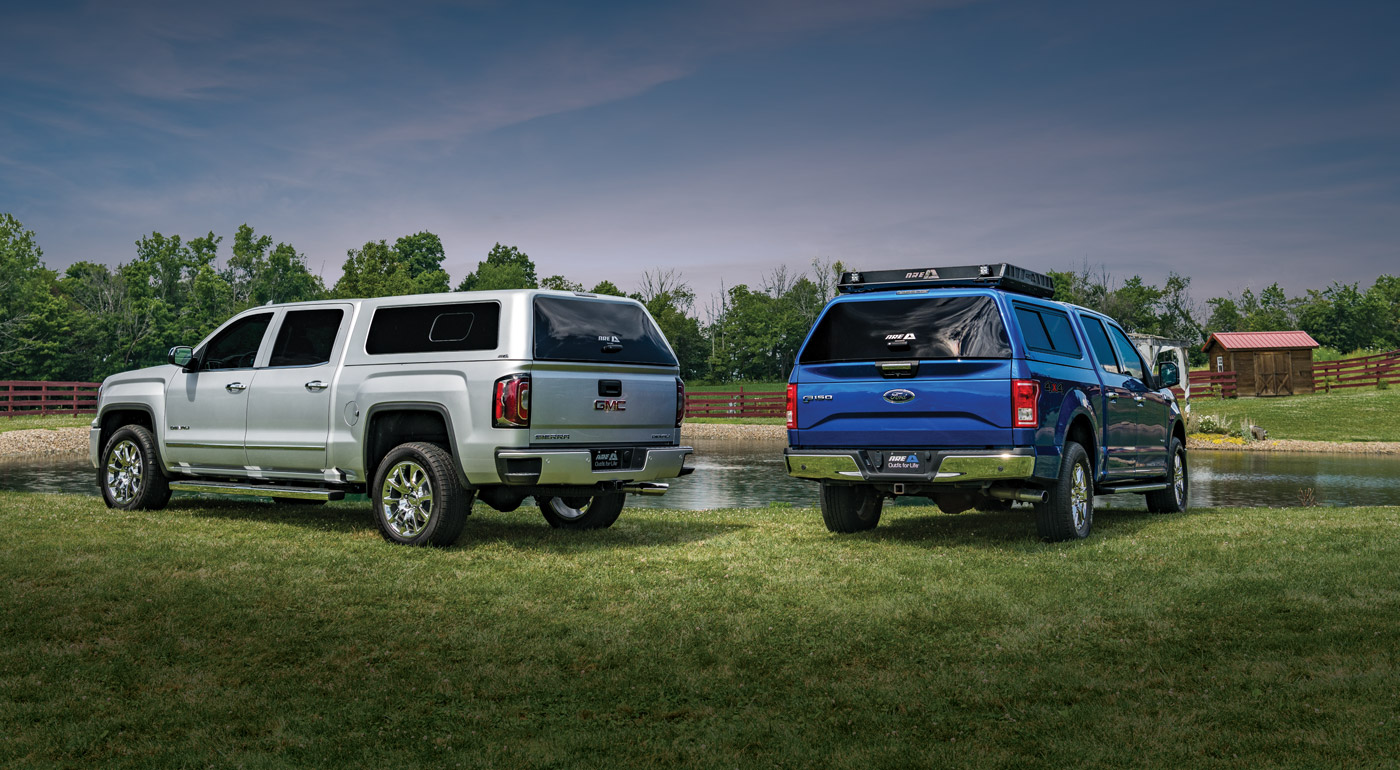Is it a Jeep? A Honda CR-V? Surprise! The ultimate dinghy towing vehicle is a pickup truck, and here’s why:
Have you ever noticed how often you see pickups being flat towed behind a motorhome? It’s no accident that pickups are some of the more popular dinghy vehicles behind Class A diesel coaches. Not only are they easy to set up and tow, pickups are also without a doubt the most versatile vehicle on the road, which makes them the ultimate dinghy vehicle if your motorhome has the towing capacity.
Many RVers like to take toys with them when traveling because the gear (ATV, golf cart, motorcycle, canoe, kayak, golf clubs, fishing tackle, bicycles, etc.) is what makes RV vacations so much fun. If you’re one of those RVers who travels with all your hobbies, then a pickup could be the perfect dinghy for you. Pickups are rugged vehicles with luxurious interiors and good-looking styling, plus they also have a truck bed, which can be utilized in many different ways.

Equipping your truck with a truck cap like this CX REVO from A.R.E. makes it more versatile as a standalone vehicle and as a dinghy behind your motorhome. Photo courtesy A.R.E.
These vehicles are generally larger and heavier than most cars and SUVs, so before you decide to use a pickup as a dinghy, make sure your coach is up to the task. If you own a full-size Class A diesel motorhome (and in some cases a Class A gas motorhome), you should be able to find a pickup that is suitable to be towed behind your coach.
In order to determine how much weight your coach can tow, you’ll need to refer to the specification known as the gross combination weight rating (GCWR). The GCWR is the gross vehicle weight rating (GVWR) plus the maximum tow rating.
Here’s an example: A 2020 Tiffin Phaeton 40-foot coach (no tag axle) features a maximum weight (GVWR) of 38,320 pounds, which includes the coach, all contents, water, fuel, passengers, etc. From the specifications, below, you can see the GCWR is 48,320 pounds. The GCWR minus the GVWR equals the maximum tow rating, which, on this model, is 10,000 pounds. This coach has a Cummins ISL with 380 hp and 1,150 lb-ft torque. (Note: GAWR is the gross axle weight rating.)
2020 Tiffin Phaeton 40AH
GAWR, front 14,320 lbs
GAWR, rear 24,000 lbs
GVWR 38,320 lbs
GCWR 48,320 lbs
Towing capacity 10,000 lbs
In most cases, you don’t need a top-of-the-line diesel pusher with a huge engine to be able to tow a pickup. If your diesel-powered Class A motorhome has the smaller 6.7-liter Cummins diesel engine, it likely has enough towing capacity for a full-sized pickup, assuming it’s equipped with the correct hitch receiver.
Here’s another example using a 2020 Newmar Ventana 3709 built on a Freightliner chassis equipped with the popular 6.7-liter Cummins diesel engine and an Allison 3000MH transmission. As you can see, it also has a 10,000-pound dinghy-towing capacity.
2020 Newmar Ventana 3709
GAWR, front 13,500 lbs
GAWR, rear 24,000 lbs
GVWR 37,500 lbs
GCWR 47,500 lbs
Towing capacity 10,000 lbs
If your Class A is built on the Ford F-53 gas engine chassis, the dinghy-towing capacity is likely lower than diesel models. Make sure you fully understand the GCWR of your motorhome and the weight of the truck you are considering before you make any decisions. In most cases, the Ford F-53 chassis is delivered from the coachbuilder with 4,000–6,000 pounds of towing capacity.
Again, adding up the pieces is important. Your motorhome must have adequate towing capacity, the proper hitch receiver and the proper towing gear.
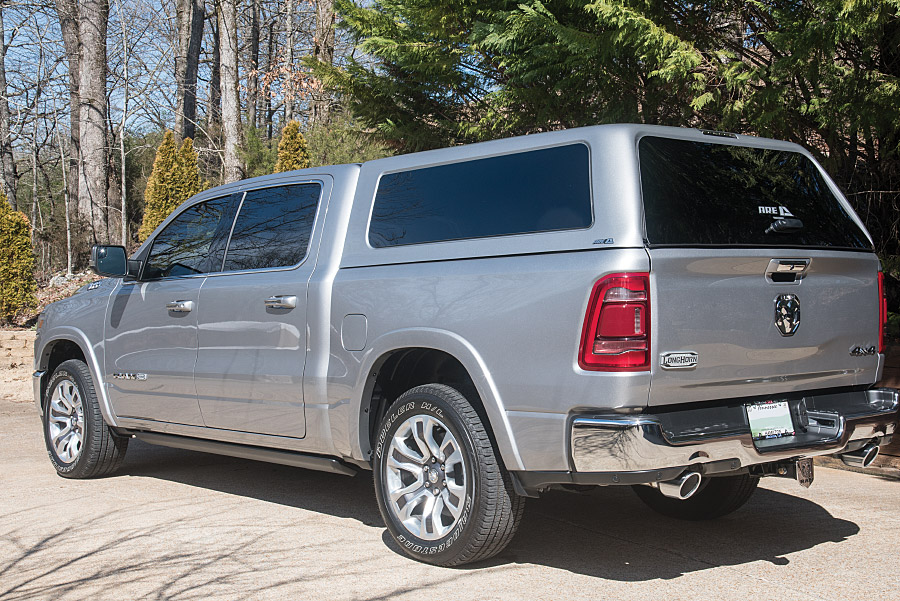
Modern truck caps, like this A.R.E. CX REVO, look as if they were molded to match the body lines because they were. Note the frameless windows on the side and back, which really add to the clean, sleek design. Photos by E. Don Smith
Although a lot of automobiles and SUVs can be towed, some require the use of a dolly or a trailer (to get two, or all four, wheels off the road). This is because some vehicles are equipped with front-wheel drive and a continuously variable transmission (CVT), which means they can’t be flat towed. Also, some transmissions require a pump to circulate the transmission fluid for proper lubrication when being towed, as opposed to most pickups, which have a true “neutral” selection that allows them to freewheel down the road without any special preparation.
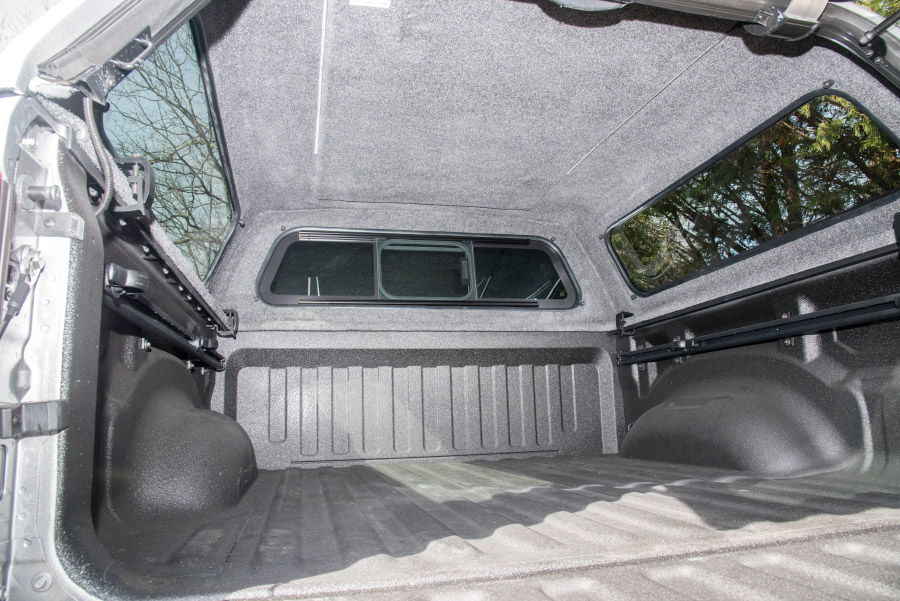
Beneath the protection of the A.R.E. CX REVO truck cap is a cavernous space of lockable storage. Note inside the fully carpeted interior and LED roof lights, which really come in handy at night.
Towing a vehicle on a dolly or trailer adds a lot of extra steps to the towing process; this can be avoided if you select the right pickup. Towing a vehicle “four wheels down” means that all you have to do is attach it to the motorhome with a tow bar, follow the manufacturer’s towing instructions, set up the lighting and auxiliary braking system, and start driving. Towing four wheels down is the easiest and often least expensive way to tow, so if you’re searching for a new vehicle and want to make sure it’s capable of being towed four wheels down, refer to our list of pickups approved by their respective manufacturers for dinghy towing.
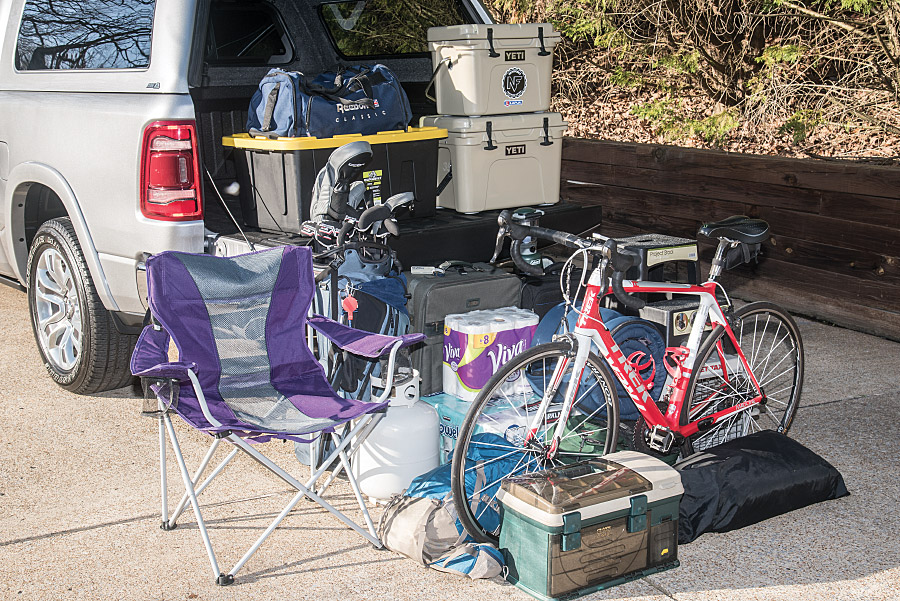
On this truck with a hitch receiver-mounted bike carrier we were able to easily pack all of this gear inside the camper shell with room to spare.
In addition to the functionality of a pickup with regard to its cargo capacity, the basic design and transmission lends itself well to dinghy towing. Most 4WD mid- and full-sized trucks are perfectly suited for towing with no special equipment needed other than a supplemental braking system, wiring, tow bar and a baseplate. Depending on the vehicle, you may also need a battery disconnect kit (for vehicles that require the negative battery cable be disconnected).
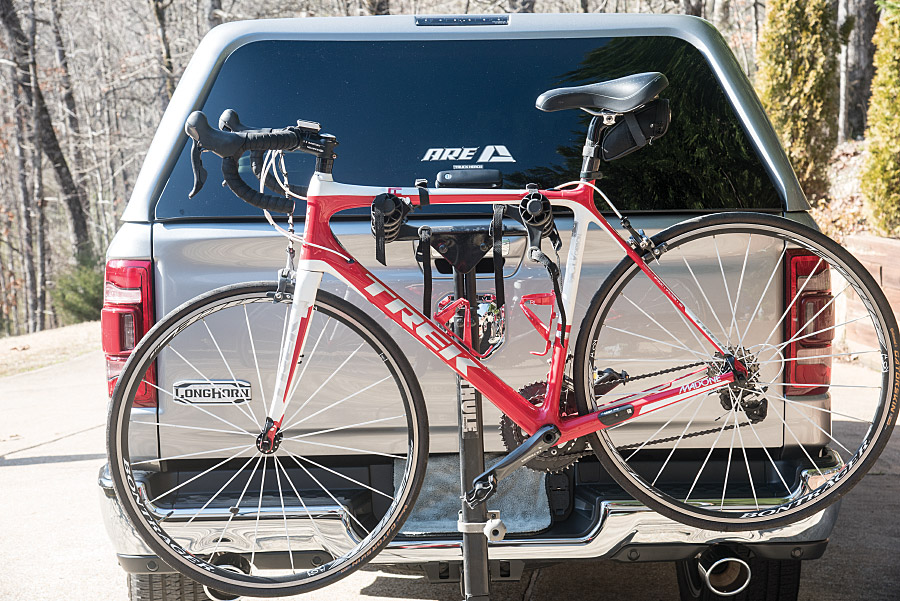
After loading all that gear inside the truck bed, we can still use the hitch receiver to carry one or more bicycles.
Beyond the ease of setting up a pickup to be towed, one of the most obvious advantages of the pickup is its truck bed. The bed offers tremendous flexibility because it can be set up so many different ways to carry gear. For example, if you want to haul a golf cart, motorcycle(s), scooters or even a small ATV, you can likely carry it in the back of the uncovered truck bed and your only concern is making sure you don’t exceed the weight ratings of the pickup and motorhome. Plus, you can customize the pickup bed (see Truck Bed Solutions, below).
If you decide to shop for a dinghy-towable pickup, there’s no better place to start than MotorHome’s annual Guide to Dinghy Towing (www.motorhome.com/download-dinghy-guides), which includes details on specific trim levels along with the vehicle weight, MSRP, fuel economy and the steps involved for dinghy-towing preparation.
Below is a list of 2020 model-year trucks rated to be towed four wheels down by their manufacturer:
 As you can see, there are plenty of pickups to choose from and lots of advantages to using one as a dinghy, including tremendous flexibility and storage capacity. Plus, when you arrive at your destination, you have a truck (and its pickup bed) to use as needed. If you are a full-time RVer and own an RV lot, having a pickup makes taking care of said lot easier. When it comes time to haul some landscape materials or a new patio set back to your home on the road, just toss it all in the truck bed. Also, trucks that can be towed are frequently four-wheel-drive models, further increasing their flexibility for off-pavement adventure or for getting around in snow or other difficult conditions.
As you can see, there are plenty of pickups to choose from and lots of advantages to using one as a dinghy, including tremendous flexibility and storage capacity. Plus, when you arrive at your destination, you have a truck (and its pickup bed) to use as needed. If you are a full-time RVer and own an RV lot, having a pickup makes taking care of said lot easier. When it comes time to haul some landscape materials or a new patio set back to your home on the road, just toss it all in the truck bed. Also, trucks that can be towed are frequently four-wheel-drive models, further increasing their flexibility for off-pavement adventure or for getting around in snow or other difficult conditions.
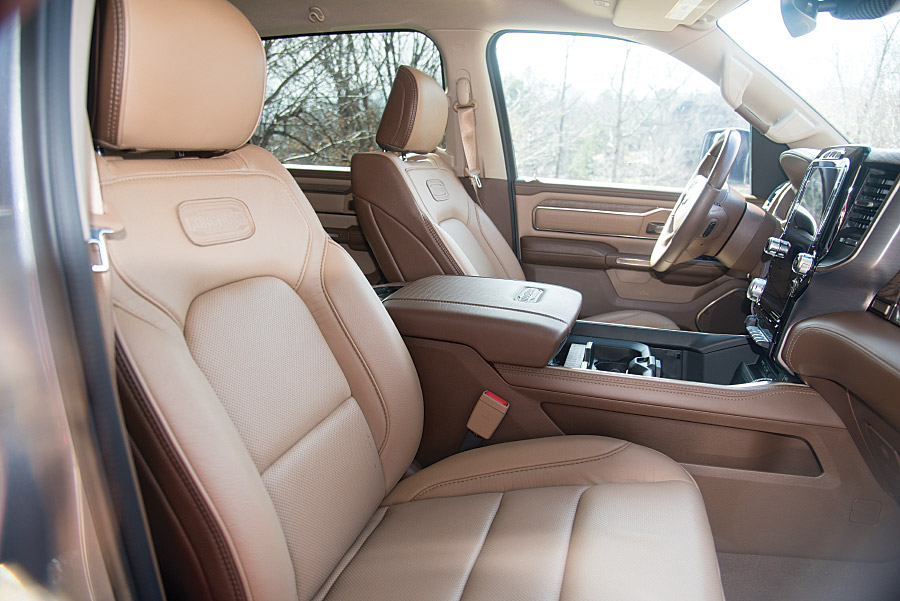
Today’s trucks offer unmatched luxury, as shown in this 2019 RAM 1500 Longhorn edition. If you want a comfortable vehicle that can haul six people and still do some work, look at the top trim levels of the major manufacturers’ trucks. Plus, the rear seats can be raised up to allow even more storage on the rear floorboard.
When looking for a vehicle that comfortably hauls six people and more than 1,000 pounds of cargo with ease, nothing beats a pickup. And, consider this: Before you decide against a pickup as a dinghy vehicle because it’s “too crude” or “not comfortable enough,” take note that www.cars.com voted the 2020 RAM 1500 Crew Cab (Limited or Longhorn) the luxury vehicle of the year. Safe to say the pickups of today are not the same as they were 20 years ago.
Truck Bed Solutions
For many owners, the pickup bed is a blank canvas that can be set up exactly the way they want to haul and protect gear they don’t want exposed to the elements. There are many different types of bed covers on the market today, and they all have their strengths and weaknesses. Proper research before buying is definitely in order.
Camper Shell (Truck Cap)
I have used camper shells (also known as truck caps or toppers) on pickup beds for several decades and have always enjoyed the many benefits they offer for both camping and non-camping trips. These stylish caps are offered in many different sizes and types with some being cab-height, which offers an SUV-like look. If you need maximum cargo storage, you can choose a model with a raised roof, offering even more covered capacity.
The major advantages of a camper shell are:
1. Locking storage for your contents
2. Protection of contents from rain, snow and UV damage
3. Easy access and a large storage area
4. The cap can be removed if needed (but it may take several people)
5. Stylish and color matched to your pickup
6. Racks can be added on top for canoes or other cargo

A.R.E. LSII series fiberglass tonneau cover that is painted to match the truck. This type of cover is great as long as the cargo is never higher than the bed rails. They are lockable, waterproof and they look great. Another important feature is that they can be easily removed by two people if needed. Photos courtesy A.R.E.
Hard Fiberglass Tonneau Cover
These attractive covers clamp onto the bed rails and, like the camper shell mentioned above, offer weatherproof locking storage for your contents. They are attractive and paint matched to your pickup, plus they offer all the security of a camper, but with a much smaller cargo area. Since these covers sit on top of the bed rails, the storage area inside is not nearly as great as a camper shell. Also, if you ever need to carry an item taller than the height of the bed rails, you will have to remove the cover.
Retractable Cover
These covers feature a roll-up design that stores into a canister in the front part of the bed. These are less expensive than a full fiberglass tonneau cover and they offer good security with a lockable design. The main advantage is that when rolled up they allow you to carry a taller item in the bed without removing the cover. Storage space of a retractable cover (when closed) is the same as a fiberglass tonneau, as it’s the same height as the bed rails of the truck. The two disadvantages are that the canister in the front of the bed occupies some of the bed space, and this type of cover is not as waterproof as a camper shell or fiberglass tonneau.
Roll-up Cover
The most economical bed cover, roll-ups are usually made from vinyl and seal off on the sides with hook-and-loop fastener and do a reasonable job of protecting the contents from weather. These covers are not lockable and are subjected to UV damage, so frequent cleaning and protection are required. The life of these covers is not as long as the other models, but they are the least expensive by far. If you want the advantages of a soft roll-up cover but want a little more durability, you can also get a hard-rolling cover. Some lock like a retractable cover, and they are a lot more durable.

With the A.R.E. FUSION cover folded open you can easily access cargo or carry an item taller than the bed rails without removing the cover.
Hard Folding Cover
These also sit on top of the bed rails. Unlike the soft vinyl roll-up covers that offer virtually no theft protection, these hard panel covers are lockable and offer good security for your contents. Unlike retractable covers, these fold up (usually in three or four segments) and therefore do not have a bulky canister in the front of the bed when you need to carry something larger. Also, with multiple segments you can opt to open one, two, or all sections when you need to carry something taller than the bed rails — or you can remove it completely. Until recently, most of these types of covers were made from a black material (aluminum or polymer Styrofoam laminated panel) and depending on your styling, they weren’t too attractive. The new FUSION from A.R.E. is an aluminum folding cover that can be painted to match your vehicle. The FUSION clamps on the bed rails and can be installed or removed in less than 30 minutes.
Truck Hero (A.R.E. and Retrax), 877-875-4376, www.truck-hero.com
And for more information on all things dinghy towing, check out our Dinghy Towing page.

